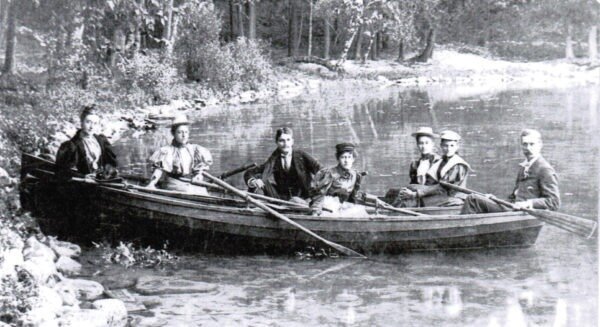Cryptid Profile: Parker's Snake
According to science, there are nearly 3,000 different species of snake currently sharing the planet with humans. They exist on almost every continent (besides Antarctica) and for the most part, a good majority of them are relatively harmless to humans. But then there are the ones that aren't harmless, the ones that are dangerous and full of venom, the ones that should be avoided by all except trained experts.
Out of all the documented snakes in the world, only around 357 falls into this category of both dangerous and venomous. And as far as mainstream science is concerned, Ophiologists (scientists in the branch of herpetology that only study snakes) have all these species documented and categorized. But here's the big question, what if they didn't? Could they have missed number 358? If you ask that question to the people of New Guinea, the answer is yes.
In the 1970's, a young herpetologist and Kiap (patrol guard and representative of the British and Australian governments with wide-ranging authority in pre-independence New Guinea) by the name of Fred Parker was traveling around the island collecting different snake specimens for various museums when he came across the story of a deadly, unidentified species. Parker was told of the snake, which officially had no name, by local natives living near Ouwe Creek in Wipim, which is located in the Western Province of New Guinea. He would later go on to recount this story in "The Snakes of Western Province" which was published in 1982.
In his retelling, Parker wrote of three young girls who were bathing in Ouwe Creek and unfortunately happened to encounter the unknown snake. The reptile was said to have quickly bit all three girls, completely unprovoked, which caused them to scramble for shore screaming. As soon as the girls reached the shore though, they were as good as dead. The fast-acting venom had begun to shut down their organs and drain the life from them. And within just a short amount of time, they had perished.
The villagers were said to have scrambled to catch the snake in order to kill it, but it was too late, the unknown creature was gone and would not be seen in the area again. While they weren't able to capture it, they did manage to get a somewhat decent look at the animal. Sadly though, they were never able to identify it, even after describing it to Parker, a snake expert.
In their account of that tragic day, the locals described the mystery snake to Parker. The locals reported the snake as being over 6ft long and having extremely smooth, almost shiny scales. The animal was a dark, uniform color on top and bottom, had a short tail in relation to the main body, and was well adapted to water. The snake was also extremely fast and appeared to have no fear of humans by how easily it approached and attacked the girls.
While Fred Parker was unable to officially identify the mystery snake in question, other herpetologists over the years have made several attempts to do so. Many strongly believe that what the three girls unfortunately encountered that day was a Zweifeli's Beaked Seasnake (Enhydrina zweifeli), a highly venomous and highly aggressive species of sea snake found throughout the waters around New Guinea and Australia (also relatively widespread, and being one of the most common sea snake encountered by humans).
While this snake seems like it could be a good match for what the girls encountered that day, there are a few major issues that arise when comparing the two. The first of these differences is the size of both creatures. You see, the Beaked Sea Snake typically only grows to a length of around 3-4ft, while the one described by locals was said to be well over 6ft in length.
Another issue that comes into play is the color of the reported snake. The creature that was believed to have killed the girls was reported as being uniformly dark in color, while the Beaked Sea Snake is typically more of a dirty gray-white and pale green color. They also possess around 50 dark scale patches along the length of the back. Dark blotches or scale patterns were not reported by the locals after the attack.
Finally, the last major difference between the two snakes is how fast the venom seemed to act. Typically, it can take anywhere from around 30mins to a few hours for Beaked Sea Snake venom to affect/kill a human, if they can even get their tiny fangs to penetrate your skin. But Parker's Snake appeared to have venom that was much more potent and was able to kill three individuals in just a matter of minutes. There is currently no known snake venom in the world today that is able to kill that fast.
Now, while there does appear to be some major differences between the snake responsible for the deaths and the scientifically assumed suspect, this may honestly still be the same animal. It is well understood that during a moment of great commotion or panic, ones ability to truly focus on a specific object becomes hindered. And this may be a reason as to why this snake could have possibly been misidentified.
Remember, the three girls were said to be bathing in the water at the time of the attack when they suddenly ran onto shore screaming, this act alone would cause a great deal of confusion to those on shore not expecting it to happen. Now, add in the fact that the girls are literally beginning to die and begging for help, and it becomes more difficult to believe that either someone or a group of people just turned away and began watching the moving water with such focus that they caught sight of a dark colored snake swimming away in the even darker water.
But then again, it could have happened that way. Someone may have had the instant thought to see what was responsible, perhaps to possibly help with an anti-venom in some way. Or perhaps they were so used to dealing with sea snake bites, that they already knew what kind of creature they were looking for. It just so happened that this time, they saw a snake they had never seen before. There are just too many scenarios this event could fall into.
While its hard to truly settle on what kind of snake Parker's Snake was simply from the one story above, it's easy to see why herpetologists have settled on Zweifeli's Beaked Seasnake, it's an aggressive snake that lives in the area and frequently is reported to bite humans. And besides, even if scientists hadn't settled on that particular snake, they had 59 other known species to choose from that all call the tropical waters of the Pacific Ocean home. Perhaps it was an Olive Sea Snake, a Port Darwin Mudsnake, or even a Large Headed Sea Snake with a color mutation that the girls encountered that day. All highly venomous and all reported around the area.
So, maybe that day the villagers really did encounter a snake that they had never seen before, but it just so happened to be a snake that science had seen before elsewhere, just not in their creek. Perhaps an already known species had wandered farther from its normal open ocean boundaries and happened to swim upstream to Ouwe Creek that day. By doing so though, it, unfortunately, ran into three young girls who weren't prepared to deal with it.
So what do you think, is Parker's Snake nothing more than an already known species that just so happened to be in the wrong place at the wrong time? Or could this truly be a new and even deadlier species of sea snake than originally thought? You heard the same story that Fred Parker did, so you be the judge.
-The Pine Barrens Institute
Image Credit: Google
Do you have a strange tale, family legend, or odd sighting you would like to report? Get in touch with us here to share what you know!
Want more strange stories in your life? If the answer is yes, then make sure to check out our books ‘Monsters In Print: A Collection Of Curious Creatures Known Mostly From Newspapers’ and ‘Ghosts In Print: An Assemblage of Spirits, Spooks, and Specters From Newspapers of Old’, both available from Amazon!
Make sure to also check out our shop for official PBI shirts, totes, buttons, and stickers!































